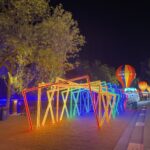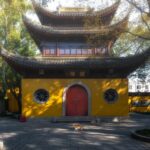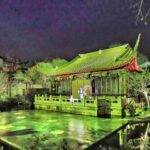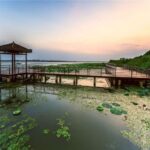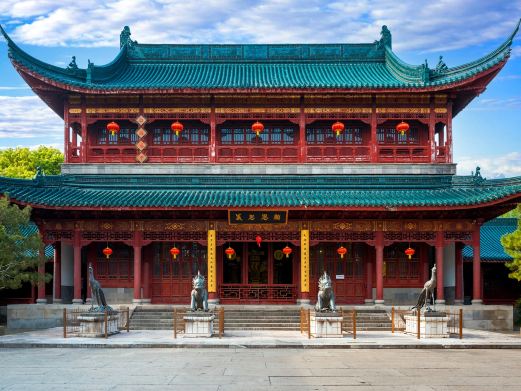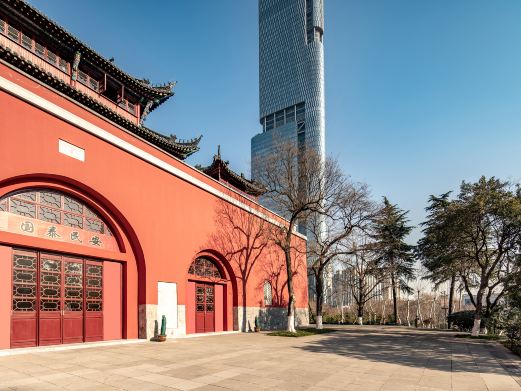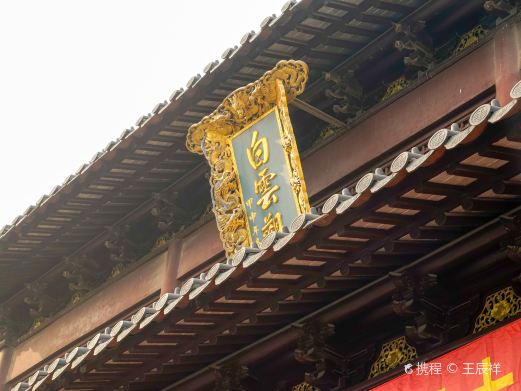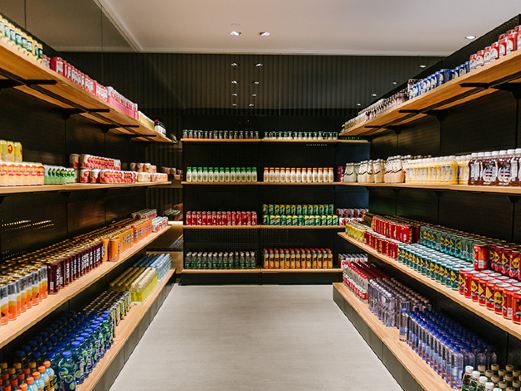Huishan Ancient Town Scenic Area is located to the north of Xihui Park in Wuxi, formed by the merger of the original Xihui Park (Xihui Scenic Area) and Huishan Historical and Cultural Block. It is divided into four tourist areas based on regional functions: Cultural Relics and Historical Sites Area, Xihui Scenic Area, Historical and Cultural Block, and Forest Conservation Area. The scenic area covers an area of 3.
5 square kilometers, with a core area of 1.09 square kilometers. Xihui Park (Xihui Scenic Area) is a national key park, also known as Xihui Scenic Area, and is a national key scenic spot; Huishan Historical and Cultural Block is a Wuxi municipal historical and cultural block, and Huishan Old Street is rated as a Chinese historical and cultural famous street; Huishan Ancestral Halls are on the preliminary list of China’s World Cultural Heritage. The ancestral halls were first built in the Tang Dynasty and flourished in the Ming and Qing Dynasties, with most of what we see today being Qing Dynasty halls. These halls involve more than 80 surnames, making it a great place to trace one’s ancestry. Additionally, Wuxi clay figurines in the town make for excellent souvenirs, and the local cuisine is worth tasting. Huishan Ancient Town Scenic Area boasts numerous cultural relics and historical sites, as well as excellent landscapes of mountains, waters, forests, and springs. There are over 200 scenic spots, including ancient streets, gardens, temples, springs, academies, poetry societies, and ancestral halls, spanning thousands of years of history. The area is known as an open-air history museum and a spiritual home for the people of Wuxi, with 23 city-level and above cultural relics protection units. Famous attractions include Liangzhu Xishan Ancient Site, Spring and Autumn Period Spring Shenjun’s Drinking Horse Site, Southern and Northern Dynasties Huishan Temple Gardens, Tang Dynasty’s Second Spring in the World, Song Dynasty Golden Lotus Bridge, Ming Dynasty Ancient Garden Jichang Garden, Yugong Valley, Ming Dynasty Erquan Academy, and Bishan Poetry Society, as well as 118 ancestral halls and gardens from the Tang Dynasty to the Republic of China period, Erquan Yingyue and Abing Cemetery. There is also a specialized botanical garden – China Rhododendron Garden. In spring, there are rhododendrons and in autumn, there are chrysanthemums, with fragrant flowers blooming all year round. Huishan Old Street highlights the charm of a Jiangnan foothill water town, a place of outstanding people and beautiful scenery, where people trace their roots and commemorate their ancestors. Huishan clay figurines and Huishan temple fairs reflect the local customs and folk culture of Wuxi. Huishan Ancient Town is enclosed by the north-south Heng Street and the east-west Zhijie (Xiuzhang Street). At the east end of Zhijie, there is an ancient town’s large screen wall with the four characters ‘Huishan Ancient Town’, which is very recognizable; at the north end of Heng Street, where Huqian Road and Tonghui West Road intersect, is the ticket office. The intersection of Heng Street and Zhijie is adjacent to the ancient Huashan Gate and Xiuzhang Gate of Xihui Park, and a bit further north is the Renjiedi Ling牌坊, behind which the spring water from Huishan flows into Chengshui Well, and the Longtou River flows from southwest to northeast into the Grand Canal from here. Ancestral halls are mainly concentrated along the Longtou River and Zhijie, with fewer on Heng Street. In addition to the scenic spots that can be visited with a ticket, many ancestral halls are not open to the public and can only be viewed from the outside, with signs at the entrance of each hall.Most of the ancestral halls are typical Jiangnan architecture, with white walls, black tiles, and wooden doors and windows. Some have small gardens of their own. The Yang Ou-fang Ancestral Hall is relatively special, incorporating Western architectural styles and somewhat resembling a Shikumen built of bricks and stones. Along the Longtou River, from southwest to northeast are successively Qianlu (Liugeng Thatched Cottage), Wuxi Intangible Cultural Heritage Exhibition Hall, Yang Ou-fang Ancestral Hall, Lianxi Zhou Master’s Ancestral Hall (Guangji Ancestral Hall.
Zhou Lianxi is Zhou Dunyi who wrote ‘On the Love of Lotus’). Huishan Garden (Li Gongci. Li Gong is Li Hezhang, the brother of Li Hongzhang). A small path behind the Yang Ou-fang Ancestral Hall leads to the Ancestral Hall of Mr. Gu Dongyang (Gu Kejiu Ancestral Hall). There is a tall Taihu stone in the garden of the ancestral hall. The attractions on Zhijie Street that require tickets are, from west to east, the Ancestral Hall of Mr. Ni Yunlin, the Ancestral Hall of Fan Zhongyan, the Ancestral Hall of Lu Xuangong, and the Ancestral Hall of Xu Ruzhi. The attraction at the northeasternmost end along the Longtou River is the China Clay Figurine Museum, which also requires tickets. Inside the museum, you can see both the Wuxi Dafu of the southern school and the clay figurines of the northern school’s Ni Renzhang. You can also see the process of masters making clay figurines. If you like, you can buy Wuxi clay figurines inside the museum. Of course, strolling in the ancient town outside the museum, you can also find clay figurines. For those seeking a petty bourgeoisie atmosphere, the trees on both sides of the Longtou River are shady and colorful umbrellas are lined up. Sitting by the table under the sunshade, drinking coffee or ordering a pot of tea, with the gentle river breeze blowing by, it couldn’t be more惬意. Nanjing’s Librairie Avant-Garde has opened a branch in the ancient town (No. 186, Xiuzhang Street). Inside the wooden flower windows, there is a literary atmosphere. The delicious food in the ancient town should not be missed either. Wuxi Huishan tofu pudding (No. 13, Hengjie Street) often has queues. The Yi Qin Yuan small steamed buns not far from it are said to have been on ‘A Bite of China’. Crab roe small steamed buns are the signature dish. The old restaurant (No. 3, Xiuzhang Street) mainly serves exquisite Wuxi cuisine. The Suzhou-style noodles at One Mu and Three Fen Fields (No. 24, Xiuzhang Street) are excellent. Shortbread is even more of a specialty here. Walking two steps in the ancient town, you can see a shortbread shop. You can buy some and eat while strolling. Huishan Ancient Town and Xihui Park can be visited together. In the park, there are famous attractions such as Jichang Garden and the Second Spring under Heaven that gave birth to the erhu masterpiece ‘The Moon Reflected on Second Spring’. Opening hours: From February 26 to September 30, Monday to Friday, open from 08:00 to 16:30; From October 8 to December 31, Monday to Friday, open from 08:00 to 16:30; From February 26 to September 30, Saturday and Sunday, open from 08:30 to 17:00; From October 8 to December 31, Saturday and Sunday, open from 08:30 to 17:00; From October 1 to October 7, open from 08:00 to 16:00. Opening times: Xihui Scenic Area: 7:00, Cultural Relics and Historic Sites Area: 8:00, Yinyuan Park: 8:00. Preferential policies for children: Those with a height of 1.
Free admission for children under 4 meters in height (excluding); half-price admission for individuals aged 6 to 18 years old (inclusive) and above 1.4 meters in height (inclusive). Elderly: Free admission for those aged 70 and above (inclusive) with a senior citizen card or ID card; half-price admission for those aged 60 to 70 years old (exclusive of 70) with a senior citizen card or ID card. Student discount: Half-price admission for full-time primary, middle, and high school students with a student ID.
Military personnel: Free admission for active-duty military personnel with an officer’s ID; discounted admission for retired military personnel with a preferential treatment certificate for retired soldiers. Disabled individuals: Free admission with a disability certificate (tickets exchanged at the ticket office). Active firefighters: Free admission for active firefighters with a firefighter’s ID. Blood donors: Free admission with a blood donation triple card. Service facilities: Luggage storage, reference price: free.
